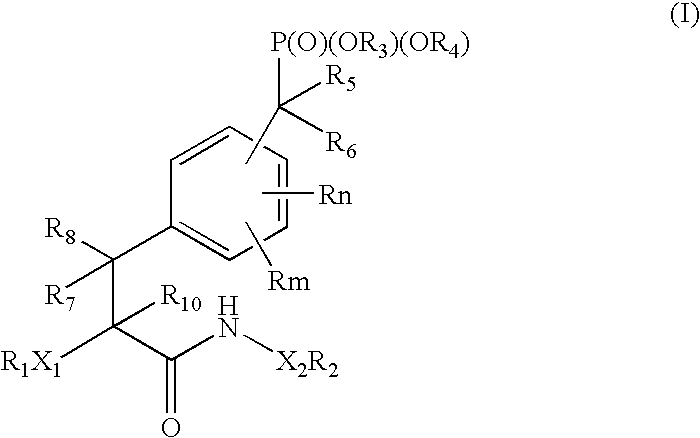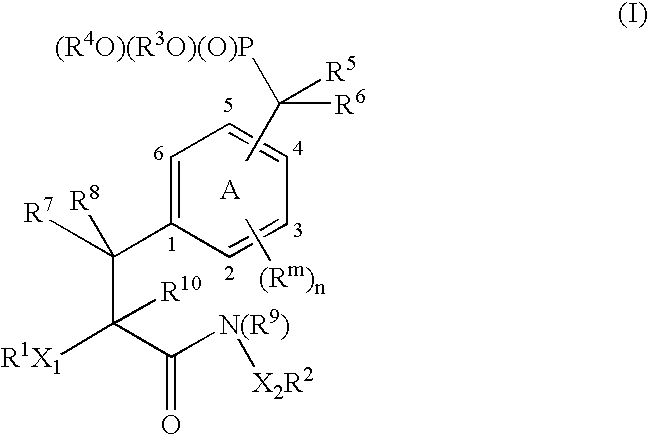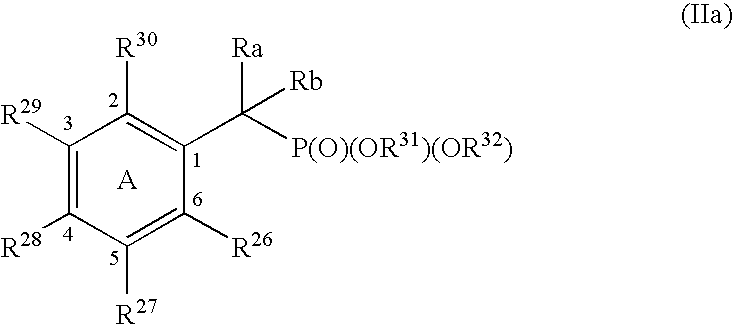Protein tyrosine phosphatase inhibitors and methods of use thereof
a phosphatase inhibitor and protein technology, applied in the direction of phosphorous compound active ingredients, drug compositions, metabolic disorders, etc., can solve the problems of insufficient insulin production, inability to effectively use available cells and tissues, and inability to effectively use available resources
- Summary
- Abstract
- Description
- Claims
- Application Information
AI Technical Summary
Benefits of technology
Problems solved by technology
Method used
Image
Examples
example 1
Synthesis of Compound 1
(2S)-{4-[2-(5-Dimethylamino-1-naphthyl)sulfonylamino-2-(4-phenylbutylcarbamoyl)-ethyl]-phenyl}difluoromethylphosphonic acid
[0237]
[0238] To a suspension of Cd metal (15.2 g, 0.135 mole) in DMF (125 mL, dried over 4 Å molecular sieves for 24 hours) was added diethyl bromodifluoromethylphosphonate (21.7 mL, 0.122 mole) and glacial acetic acid (1.6 mL). Within 4 minutes an exotherm started and lasted for 20 minutes. The suspension was stirred for 3 hours and allowed to stand at room temperature for 30-40 minutes. A 100 mL aliquot of this solution was then added to methyl N-Boc 4-iodophenylalanine (11.0 g, .027 mole) followed by the addition of copper (I) chloride (10.7 g, 0.108 mole) and the reaction was stirred vigorously for 18 hours. The remaining cadmium reagent solution was then added to the reaction mixture and the reaction was stirred for additional 48 hours. Ether (Et2O, 1000 mL) was added and the reaction mixture was filtered through Celite®. The Celite...
example 2
Synthesis of Compound 2
(2RS)-{4-[2-Benzenesulfonylamino-2-(4-phenylbutylcarbamoyl)-ethyl]-2-bromo-phenyl}difluoromethylphosphonic acid
[0242]
[0243] A. The cadmium reagent was generated as in Example 1 using Cd metal (8.5 g, 0.075 mole), diethyl bromodifluoromethylphosphonate (18 g, 0.068 mole) and AcOH (1.0 mL) in DMF (80 mL). A 40 mL aliquot of this solution was added to CuCl (6.72 g, 0.068 mole) followed after 2 minutes by the addition of 3-bromo-4-iodotoluene (5.0 g, 0.017 mole). The reaction suspension was stirred for 28 hours, then more cadmium reagent solution (30 mL) was added and the reaction stirred an additional 4 days. Ether (700 mL) was added and the solution was filtered through Celite®. The Celite® cake was washed with additional ether (300 mL) and the combined ether layer was washed with saturated ammonium chloride (500 mL) and water (500 mL) then dried over magnesium sulfate. Filtration and solvent evaporation left behind 8.5 g of crude product. Flash chromatography...
example 3
Synthesis of Compound 3
(2RS)-(4-{2-Benzenesulfonylamino-2-[4-(2-methoxycarbonyl-3-hydroxy-phenoxy)-butylcarbamoyl]ethyl}-2-bromophenyl)difluoromethylphosphonic acid diethyl ester, and (2RS)-(4-{2-Benzenesulfonylamino-2-[4-(2-methoxycarbonyl-3-hydroxy-phenoxy)-butylcarbamoyl]ethyl}-2-bromophenyl)difluoromethylphosphonic acid
[0247]
[0248] (2RS)-(4-{2-Benzenesulfonylamino-2-[4-(2-methoxycarbonyl-3-hydroxy-phenoxy)butylcarbamoyl]ethyl}-2-bromophenyl)difluoromethylphosphonic acid diethyl ester (Compound 3A) was prepared from the sulfonamide acid obtained in Example 2B following a procedure similar to Example 2C except that 2-(4-amino-butoxy)-6-hydroxybenzoic acid methyl ester was used instead of phenbutylamine. The 2-(4-amino-butoxy)-6-hydroxy-benzoic acid methyl ester was prepared by taking a solution of 2,6-dihydroxymethylbenzoate (1.0 g, 5.95 mmol), 1.5 equivalents N-Boc aminobutanol and 1.5 equivalents of triphenylphosphine (2.34 g, 8.93 mmol) in 40 mL of CH2Cl2 and adding 1.5 equiv...
PUM
| Property | Measurement | Unit |
|---|---|---|
| Electrical conductance | aaaaa | aaaaa |
| Biological properties | aaaaa | aaaaa |
| Sensitivity | aaaaa | aaaaa |
Abstract
Description
Claims
Application Information
 Login to View More
Login to View More - R&D
- Intellectual Property
- Life Sciences
- Materials
- Tech Scout
- Unparalleled Data Quality
- Higher Quality Content
- 60% Fewer Hallucinations
Browse by: Latest US Patents, China's latest patents, Technical Efficacy Thesaurus, Application Domain, Technology Topic, Popular Technical Reports.
© 2025 PatSnap. All rights reserved.Legal|Privacy policy|Modern Slavery Act Transparency Statement|Sitemap|About US| Contact US: help@patsnap.com



